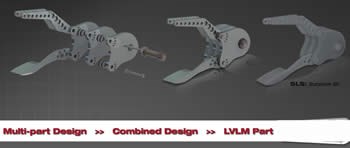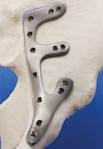Low-Volume Layered Manufacturing: Parts without Limits
An alternative design and manufacturing method that uses a layer-by-layer process, virtually eliminating part design constraints that exist with traditional manufacturing processes, such as CNC machining and injection molding.
Low-volume layered manufacturing (LVLM) is a design-thru-manufacturing method that is already known by many different names in the short time it has been an option for engineers. Whether you call it rapid manufacturing (RM) or direct digital manufacturing, LVLM has the potential to re-define the way products are designed. This technique provides plastic engineers with a method to improve quality, decrease costs and leadtimes.
If you are involved in plastics manufacturing you can’t afford to put this article down. Knowing how to design and manufacture parts using LVLM will help you gain easily measurable project benefits by designing parts without limits. LVLM allows you to reduce cost by eliminating tooling and by reducing assembly part count via part consolidation. LVLM allows you to increase the efficiency of your development process, as you can manufacture new, slightly different parts in just a few days. The results of applying these methods are clear: better, faster designs and deployment.
LVLM Defined
LVLM is the method of using rapid prototyping (RP) equipment to manufacture end-use parts. RP machines make parts using additive fabrication—meaning the parts are made from the bottom up by adding material to the build space.
This layer-by-layer process virtually eliminates all part design constraints or design rules that exist with traditional manufacturing processes, such as CNC machining and injection molding.
Currently there are three available RP technologies that can manufacture parts suitable for use as end-use parts: fused deposition modeling (FDM®), selective laser sintering (SLS®) and stereolithography (SLA®) (see Figure 1).
Each production RP technology has its strengths and weaknesses, as described in Figure 2. In order to be viable as a replacement for traditionally manufactured parts, LVLM parts must meet the needs of the application: strong, functional, accurate and appealing. All three current technologies meet those needs. Selecting the best technology for your application depends entirely on your needs.
The Old Way
Traditional methods of design require a good understanding of the constraints imposed by the manufacturing process that will be used to make the parts. For example, parts that will be made by CNC machines must be designed without narrow deep pockets, since the rotating cutter of the CNC machine cannot cut narrow deep pockets. Parts designed to be injection molded must be designed with drafted walls in the direction of the tool movement to enable the part to release from the tool after molding. Injection molded parts must also be designed without undercut or die-locked features. These design-for-manufacturing (DFM) and design-for-assembly (DFA) rules exist to enforce the constraints of the part’s manufacturing process.
A significant challenge to the broad adoption of LVLM techniques is the education of designers in how to design parts and assemblies that take advantage of the design freedoms provided by LVLM.
Design Flexibility
Here is the good news: with LVLM these old way design rules are all thrown out the window. Since the part will be made from the bottom up, layer-by-layer, design constraints are completely eliminated.
The elimination of design constraints enables on demand product flexibility and real-time continuous improvement of products. Since parts made with LVLM have no tooling commitment, they can be improved on the fly, continuously, based on customer or performance feedback. This continuous product improvement leads to higher customer satisfaction and market responsiveness.
LVLM also enables on-demand inventory of the improved design, since the improved units can be manufactured within a few days of conception. With this method, the days of obsolete inventory are gone, since existing designs are made just-in-time, and new, improved parts can be manufactured quickly.
No Penalty for Changes
LVLM cleans up a product manager’s dirtiest word: change. Parts with tooling investment become locked in time and unchangeable, since the cost of re-working the tooling, or worse making new tooling altogether, prohibits the weak part from being changed.
When parts are designed for LVLM, they are not designed for a process that requires expensive, long-leadtime tooling. LVLM makes re-design possible, even encouraged. With no tooling investment, and newfound design freedom, part design can be improved in real-time, with new parts being manufactured in a few days.
LVLM encourages active re-design as learning occurs. Let’s call it active evolution, since the part design, and therefore product performance, can improve with each and every unit shipped. More importantly, active evolution enables you to be laser focused on the needs of your customer.
Focus on Part Consolidation
To take advantage of LVLM effectively, designers must shift their design paradigm to take advantage of part consolidation. Simply put, part consolidation is the act of combining several parts in an assembly into a single part that can easily be manufactured using LVLM. Multiple parts currently only exist because of the constraints imposed by the process used to manufacture those parts.
Since LVLM removes those constraints, the designer can consolidate the parts into far fewer parts, which can then only be made using LVLM. For example, consider the robotic arm shown in Figure 3. Notice that the original design for the wrist consists of three plates, three standoff posts and two adapters for a total of eight parts—not including the screws.
With LVLM, that assembly is combined into a single part, easily made with LVLM, but impossible to make with CNC or molding methods. The benefit? Eight unique parts are reduced to one. Tooling for those eight parts is eliminated. And the bill-of-materials is reduced by seven parts. This illustration effectively shows one of the benefits in using LVLM for part consolidation.
Assemblies as a Single Part
LVLM excels when parts are designed to be manufactured together. This is certainly a new way to think about design-for-assembly. Again consider the robotic arm of Figure 4, this time look at the hand. Its original design requires separate parts for each finger, palm pads, joint pins and washers. The LVLM version results in a complete single hand part, designed for LVLM, manufactured using LVLM, and which meets the product requirements (fully functional, accurate, strong).
And the benefits? Fifteen separate parts are reduced to one (inventory reduction). Unique tooling for each of the parts is eliminated (cost reduction, leadtime reduction). Changing the hand on-the-fly to suit customer needs is simple (small hand version, large hand version). This illustration effectively shows the benefits in using LVLM to design assemblies as a single part.
Geometry without Limits
Let’s go ahead and take a closer look at the ability for layer-based manufacturing to produce previously unthinkable geometry. Since a part is being manufactured from the bottom up, nearly all design constraints are removed. In nearly all cases, if you can design the part in a 3-D CAD software, then you can manufacture the part in an RP machine.
Limitations
All manufacturing processes have limitations, and LVLM has its own unique set as well. The most notable limitation in all layer-based manufacturing methods are the capabilities of the materials used to make parts.
RP machines have been making parts for more than 15 years, but only recently have the materials been strong enough to be used in end-use commercial applications. LVLM parts are now available in ABS, medical and food grade ABS, polycarbonate, nylon and epoxy—all with mechanical properties that are on par with production injection molded plastics.
Surface finish is in second place in the limitation race. LVLM parts cannot produce a smooth surface finish comparable to CNC machined or molded parts. LVLM processes also have well established tolerances, based on part size, which are good, but not quite as good as CNC or molded parts.
What Can You Do Now?
Review Figure 5, which shows the process from concept to CAD design to real parts manufactured on RP machines. You are now equipped with the know-how to begin applying the LVLM method to your designs. Consider your past design approach. Ask yourself how you have designed equipment based on the constraints of the process used to make the parts. Ask yourself what parts can be consolidated into one.
Your next step is to identify a candidate project and apply the LVLM method to create a design free from constraints. With new designs in-hand, get a quote for the manufacture of the new part in the quantities you need. See how the financial picture looks for the manufacture of your LVLM parts.
Summary
LVLM has become a useful tool for plastics manufacturers. LVLM enables designers to make dramatic improvements in quality, efficiency and cost by designing parts without limits. It enables part consolidation and freedom from the design constraints that have historically been imposed by subtractive (CNC machining) and formative (injection molded) manufacturing processes.
If you are faced with increased competition and are continually challenged to deliver better, faster and cheaper, then you should consider the use of LVLM methods to provide you with the competitive advantage you need.
Related Content
Dynamic Tool Corporation – Creating the Team to Move Moldmaking Into the Future
For 40+ years, Dynamic Tool Corp. has offered precision tooling, emphasizing education, mentoring and innovation. The company is committed to excellence, integrity, safety and customer service, as well as inspiring growth and quality in manufacturing.
Read MoreThink Safety: Eliminate Hazards Throughout the Shop
The tooling community is taking advantage of new products for safer mold shops and molding facilities.
Read MoreMMT Chats: 4 Keys to a Successful Mold-Building Operation: Innovation, Transparency, Accessibility and Relationship
MoldMaking Technology Editorial Director Christina Fuges chats with Steve Michon, co-owner of Zero Tolerance in Clinton Township, Michigan, about the excitement of solving problems, the benefits of showing gratitude, the real struggle with delegation and the importance of staying on top of technology. This episode is brought to you by ISCAR with New Ideas for Machining Intelligently.
Read MoreMaking Mentoring Work | MMT Chat Part 2
Three of the TK Mold and Engineering team in Romeo, Michigan join me for Part 2 of this MMT Chat on mentorship by sharing how the AMBA’s Meet a Mentor Program works, lessons learned (and applied) and the way your shop can join this effort.
Read MoreRead Next
Additive Manufacturing In Metal: New Option for Medical Applications
Parts produced by additive processes will require final machining or hand finishing, but allow significant flexibility in the manufacture of custom, short-run, complex or complicated-to-manufacture parts.
Read MoreHow to Use Continuing Education to Remain Competitive in Moldmaking
Continued training helps moldmakers make tooling decisions and properly use the latest cutting tool to efficiently machine high-quality molds.
Read MoreReasons to Use Fiber Lasers for Mold Cleaning
Fiber lasers offer a simplicity, speed, control and portability, minimizing mold cleaning risks.
Read More

























